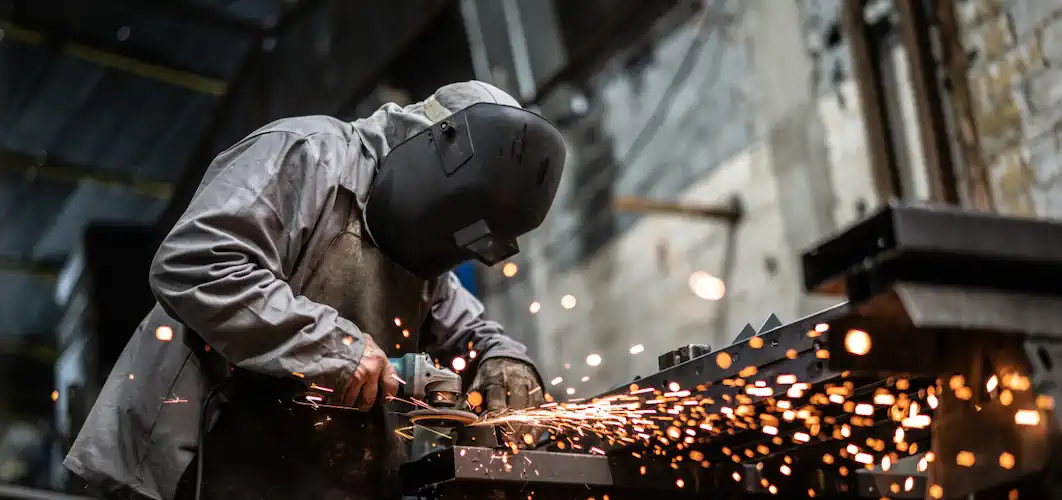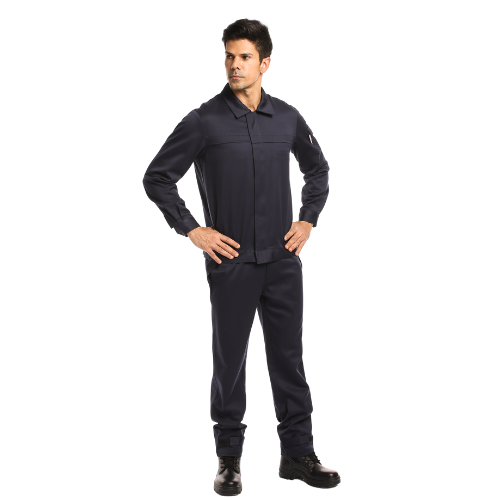How Do Fire-Resistant Clothes Work?
Fire-resistant clothes (also known as FR clothing, flame-resistant clothing, or resistant clothing) are a crucial line of defence for professionals working in environments with high fire risks. These garments protect wearers from burns and heat injuries by employing clever science and technology woven into the very fabric of the clothing.
But how exactly do FR clothes work their magic? Let's delve into the fascinating process behind this life-saving technology.
Table of Contents
-
1.The Science Behind Fire-Resistant Clothing
-
2. Beyond Fire Protection: Additional Benefits of Fire-Resistant Clothes
-
3. Common Applications of FR Clothing
-
4. Choosing the Right FR Clothing
-
5. Considerations When Buying FR Clothing: Beyond the Basics
-
6. OSHA Regulations Concerning Fire-Resistant Clothing
-
7. FR Clothing vs. Regular Clothing: Why the Difference Matters
-
8. Safety Doesn't Stop at Clothing: A Holistic Approach
The Science Behind Fire-Resistant Clothing
FR clothing achieves its protective properties through two main approaches:
Inherently Flame-Resistant Fibers
Certain materials possess inherent flame resistance due to their molecular structure. These fibers are difficult to ignite and have a low flame spread rate, meaning they won't readily contribute to a fire or catch fire easily.
Flame-Retardant Treatments
Less fire-resistant materials like cotton can be treated with special chemical finishes. These treatments create a barrier that, when exposed to heat, decomposes or releases non-flammable gases, preventing the fabric from catching fire or sustaining a flame.
Here's a breakdown of how FR clothing protects users in different scenarios:
- Ignition Resistance: FR fabrics make it significantly harder for the clothing to ignite in the first place. This is especially important for flash fires or explosions that can engulf an area in flames within milliseconds.
- Self-Extinguishing Properties: If FR clothing does come into contact with a flame, it's designed to self-extinguish once the heat source is removed. This prevents the fire from spreading across the garment and minimizes the burn duration.
- Melt Resistance: Unlike regular clothing that melts and sticks to the skin, FR clothing melts at a much higher temperature or chars instead, preventing the molten fabrics from causing further injuries.
- Heat Insulation: FR clothing provides a layer of thermal insulation, slowing heat transfer to the wearer's skin. This buys precious time for escape and reduces the severity of potential burns.
FR clothing is not fireproof. If exposed to prolonged flames, it will eventually burn. However, the crucial difference is the time it takes to ignite, self-extinguish, and the reduced heat transfer, all of which significantly improve the wearer's chances of escaping a fire safely.

Beyond Fire Protection: Additional Benefits of Fire-Resistant Clothes
While fire protection is the primary function of FR clothing, there are additional advantages to consider:
- Durability: FR fabrics are often designed to be tough and long-lasting, making them suitable for demanding work environments.
- Comfort: Advancements in FR technology have led to the development of comfortable and breathable garments that don't compromise safety.
- Style: Gone are the days of bulky and uncomfortable FR clothing. Today, FR clothing comes in a variety of styles, from FR shirts and pants to jackets and coveralls, allowing workers to choose options that suit their job and personal preferences.
Common Applications of FR Clothing
FR clothing is for professionals in various industries with inherent fire risks. Some of the most common applications include:
- Firefighters: Firefighters rely on high-performance FR gear that protects them from intense heat, flames, and chemical hazards.
- Electricians: Electric arcs and sudden bursts of electrical energy pose a serious threat to electricians. FR clothing with specific arc ratings helps mitigate these risks.
- Oil and Gas Workers: Oil and gas refineries and drilling operations involve flammable materials. FR clothing protects workers from flash fires and heat hazards.
- Chemical Workers: Chemical spills and fires are potential risks in the chemical industry. FR clothing provides a layer of protection against these threats.
- Welders: Welding fabrication generates sparks and intense heat, making FR clothing crucial for welders' safety.
Beyond these industries, FR clothing can also be used by workers in other fields, including construction, combustible dust fields, mining, and manufacturing.
Choosing the Right FR Clothing
When selecting FR clothing, consider the following factors:
- Job-Specific Hazards: Identify the specific fire risks associated with your job to choose clothing with the appropriate flame resistance and arc rating, if applicable.
- Comfort and Fit: FR clothing should be comfortable and allow for ease of movement to perform job duties effectively.
- Durability: Choose FR clothing made from high-quality materials that can withstand the wear and tear of your work environment.
- Cost: FR clothing can vary in price, but remember, it's an investment in your safety.
Always consult with a safety professional or browse the collections of reputable FR clothing brands (you can find many through a secure shopping cart on their websites) to ensure you're getting the right gear for your needs. Oftentimes, clothing that is fire resistant is not arc-rated safe so investigate thoroughly before investing.
While staying safe is paramount, the good news is that FR clothing doesn't have to compromise on comfort or aesthetics. With technological advancements, FR garments are now available in a wide range of styles, from classic workwear to more modern and athletic fits.
You can find FR jeans, black-blue fire-resistant button-down shirts, and even clothing collections with a refined look that blends safety with a touch of personal style. So, you can prioritize protection without sacrificing comfort or a sense of individuality.
Considerations When Buying FR Clothing: Beyond the Basics
While the core principles of choosing FR clothing involve hazard identification, comfort, durability, and cost, there are additional factors to consider for a well-rounded purchase:
- FR Standards and Certifications: Ensure the FR clothing meets the relevant safety standards for your industry. Common standards include NFPA 2112 for flame resistance and ASTM F1506 for electrical arc protection. Look for labels or certifications on the garment itself.
- Fabric Blend and Weight: Different FR fabrics offer varying levels of protection, breathability, and weight. Consider factors like climate and job demands when choosing the fabric weight. Lighter fabrics might be ideal to deal with hot environments, while heavier fabrics offer more protection in extreme heat situations.
- Care and Maintenance: FR clothing requires specific care to maintain its flame-resistant properties. Follow the manufacturer's washing instructions carefully, as harsh detergents or improper drying methods can compromise the effectiveness of the flame retardant treatment.
- Replacement Schedule: FR clothing doesn't last forever. The flame-resistant properties can deteriorate over time due to exposure to heat, chemicals, or regular wear and tear. Regular inspections and adherence to the manufacturer's recommended replacement schedule are crucial.

OSHA Regulations Concerning Fire-Resistant Clothing
OSHA (Occupational Safety and Health Administration) doesn't have a specific standard solely dedicated to FR clothing requirements. However, they do have general guidelines and enforce regulations through other existing standards that indirectly mandate FR clothing use in specific situations. Here's a breakdown of how OSHA approaches FR clothing:
General Duty Clause
The Occupational Safety and Health Act (OSHA Act) includes a General Duty Clause that states employers must provide a workplace "free from recognized hazards that are causing or are likely to cause death or serious physical harm." This essentially means employers are obligated to assess workplace hazards and implement appropriate safeguards, which could include FR clothing depending on the identified risks.
Specific Standards Mentioning FR Clothing
Certain OSHA standards address specific job hazards where FR clothing might be necessary. For instance:
- 1910.269 – Electric Power Generation, Transmission, and Distribution: This standard doesn't explicitly require FR clothing, but it emphasises the need for "adequate protective clothing" for electrical hazards. If a hazard assessment identifies electric arc flash risks, employers would likely need to provide FR clothing with appropriate arc ratings.
- 1910.132 – General Requirements for Personal Protective Equipment (PPE): This standard requires employers to provide "protective clothing" when hazards from "combustible liquids or vapours" are present. While not explicitly stating FR clothing, depending on the severity of the risk, FR garments might be deemed necessary to adequately protect workers.
OSHA Interpretations
OSHA issues interpretations to clarify existing standards. For instance, a 2006 interpretation clarifies that employers in the petrochemical industry, under the Process Safety Management (PSM) standard, must address flash fire hazards and potentially require FR clothing for workers in those areas.
In essence, OSHA encourages employers to conduct thorough hazard assessments to identify potential fire risks. Based on this assessment, employers have a responsibility to provide appropriate protective measures, which could include FR clothing that meets the specific needs of the work environment.
FR Clothing vs. Regular Clothing: Why the Difference Matters
While regular clothing might seem like a cheaper alternative, the potential consequences can be severe. Here's why FR clothing is the smarter choice:
- Regular clothing melts and sticks to the skin: This can worsen burn injuries significantly. FR clothing melts at a higher temperature or chars, minimizing this risk.
- Regular clothing readily ignites and burns: FR clothing offers a significantly higher resistance to ignition and self-extinguishes when the heat source is removed.
- Regular clothing offers minimal heat insulation: FR clothing provides a layer of insulation, slowing down heat transfer and potentially preventing burns.
In a fire situation, these differences can be life-saving. FR clothing buys precious seconds for escape and reduces the severity of potential injuries.
Safety Doesn't Stop at Clothing: A Holistic Approach
FR clothing is a vital component of workplace safety, but it's not the only piece of the puzzle. Here are some additional safety measures to consider:
- Safety Glasses: Protect your eyes from flying debris, sparks, or chemical splashes.
- Hard Hats: Falling objects are a major hazard in many workplaces. Hard hats provide essential protection for the head.
- Training: Proper training on fire safety protocols, evacuation procedures, and the use of FR clothing is crucial for all workers in high-risk environments.
By combining FR clothing with other safety gear and comprehensive training, workers can significantly reduce the risk of fire-related injuries.
FR clothing is a technological marvel, offering a vital layer of protection for professionals working in hazardous environments. By understanding the science behind FR clothing, its benefits, and how to choose the right gear, you can make informed decisions to prioritize your safety and well-being in the workplace. Remember, safety shouldn't be an afterthought; it's an investment in your health and a commitment to going home safely every day.




























